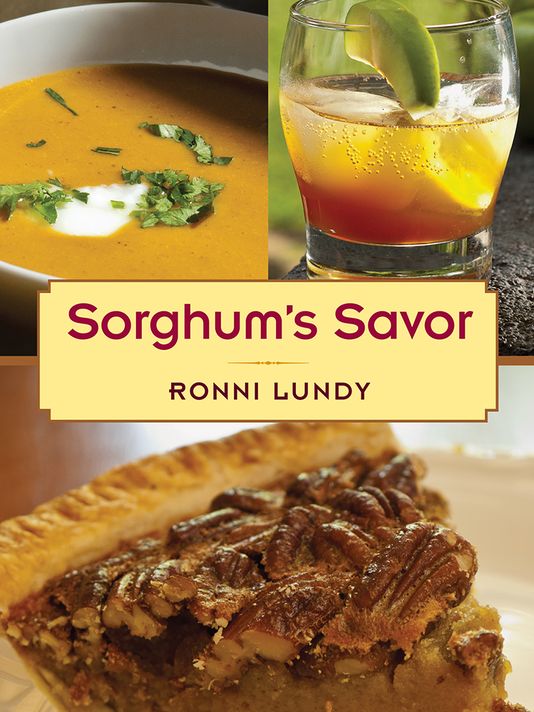“Sorghum’s Savor” begins with biscuits, butter and a childhood memory of the tangy sweet syrup shared by many from Kentucky and other parts of the South.
“When the butter is soft … the hands put down the fork, pick up a big spoon and a Ball jar full of dark, dark amber. The spoon goes in, and a thick dollop comes out and oozes down on the butter,” author Ronni Lundy wrote.
“The sensations are complicated. … There’s sweet, but with a plangent note that honey lacks. It’s a sweet that reaches down into the throat, followed by just a little sour. It tastes of earth, and grass. It fills my mouth in a way that sugar never has … and my daddy says ‘Give that baby some more ‘lasses.'”
RECIPE | Sorghum & Bourbon Pecan Pie
That is sorghum, a traditional syrup to be sought at farm stands and farmers markets and a sweetener far removed from the bitter blackstrap molasses common on grocery store shelves. This time of year, farmers are pressing tall stalks of sorghum and slow cooking down their grassy green juices into the earthy syrup that varies in color and depth from season to season, farm to farm.
“Loving sorghum syrup is a lot like loving great wine: you learn to savor impermanence and variability,” Lundy wrote.
Once you get started, you may find yourself like chef Edward Lee, whose pantry stores a collection of local varieties from pale yellow to dark brown. Lee’s sorghum obsession began while he was riding his motorcycle in Southern Indiana. He bought a jar at a farmstand, got hooked on its complexity and banned honey from the kitchen of his 610 Magnolia restaurant in Old Louisville.
“It has more depth and range than honey, a more complex umami,” Lee said in the book. “I bought a whole box filled with sorghum jars and I told my cooks, throw out the honey we have and just use this.”
Pleasure Ridge Park cook Lynn Rupley had a similar epiphany last year when she picked out a jar of Brothers Farm sorghum from a Valley Station farmers market sold by an elderly couple who grow and press the juice at home in Elizabethtown. As the widow labored over 51 pies, cookies and other culinary entries for competition at the Kentucky State Fair this summer, she was inspired by her find to enter the shoofly pie competition.
And she too recalled sorghum as a favorite childhood biscuit topping at her grandparents’ farm in Madison County near Berea College.
“Honey is real, real good … but very mild when it comes to sorghum,” Rupley, 69, said. “You eat it all your life. You learn to like it.”
“It has more depth and range than honey, a more complex umami,” Lee said in the book. “I bought a whole box filled with sorghum jars and I told my cooks, throw out the honey we have and just use this.”
Pleasure Ridge Park cook Lynn Rupley had a similar epiphany last year when she picked out a jar of Brothers Farm sorghum from a Valley Station farmers market sold by an elderly couple who grow and press the juice at home in Elizabethtown. As the widow labored over 51 pies, cookies and other culinary entries for competition at the Kentucky State Fair this summer, she was inspired by her find to enter the shoofly pie competition.
And she too recalled sorghum as a favorite childhood biscuit topping at her grandparents’ farm in Madison County near Berea College.
“Honey is real, real good … but very mild when it comes to sorghum,” Rupley, 69, said. “You eat it all your life. You learn to like it.”
With annual sorghum pressing festivals returning this fall at Crawford County High School in Indiana Oct. 17 and in West Liberty, Ky., Sept. 25-27, local residents “are sitting in heaven,” Lundy said in an interview Monday.
The light or dark color comes from the grain, the amount of potash in the ground and the variability of sun and rain.
“A darker sorghum tends to have a little more mineral taste, and a lighter sorghum tends to have a grassy taste,” said Lundy. “It tastes a little bit of the rock and the minerals in the soil.”
Sorghum’s complex umami flavor melds well with bacon drippings and lard. Other cuisines that pair well include chili-laden Mexican dishes and the aromatic curries of Indian cooking. Released in June, “Sorghum’s Savor” takes the reader on a lyrical journey through recipes compatible with the cane adopted by the South when the Civil War restricted the flow of sugar. Sprinkled throughout is the history and lore of the cane, with profiles of sorghum processors and chefs across the South.
Among Lundy’s favorites is a popcorn made with sorghum, butter and bacon grease, a snack she called “Jimmy Crack Popcorn.” A recipe for “Splendid Chai” is “just outrageous,” Lundy said.
For starters, I recommend the recipe for “Gravy Horse” on page 55. Mash together one tablespoon softened butter and two tablespoons sorghum syrup with a fork for daubing on hot biscuits. Country music legend Chet Atkins liked it that way and sometimes got fancy by adding peanut butter.
JDowns@Courier-Journal.com.



